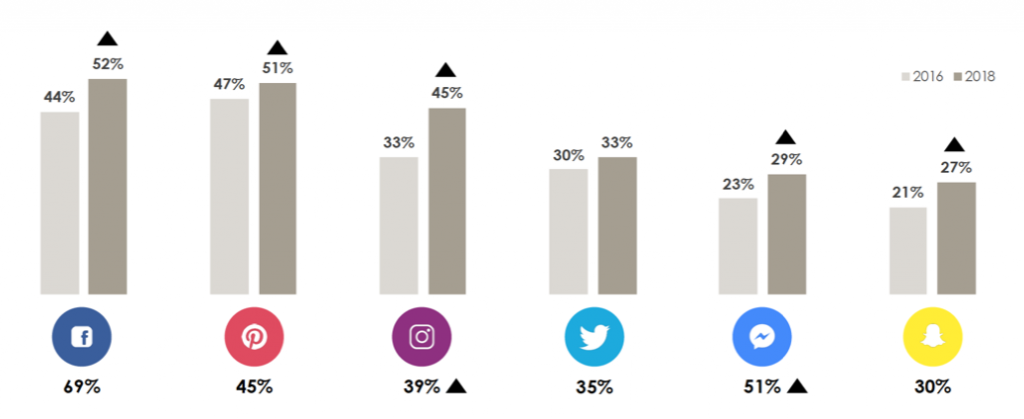Destination shopping knows no boundaries when ecommerce becomes a social experience
As consumers grow more comfortable with the one-click efficiency and ease of social shopping, social networks have responded with new commerce features and ad units to help advertisers adapt to this new realm of digital marketing.
According to composite platform data from Adobe, over the last two years traffic to U.S. retail sites from social media networks grew 110%, while direct traffic to retail sites dipped 18%. These numbers underscore an opportunity for marketers to capitalize on the highest points of a user’s purchase intent, which often occur during a social media session when a friend, influencer, or advertisement has inspired them to make a purchase.

Across social networks, social shopping has risen among shoppers who use social networks.
By understanding and utilizing the latest social shopping trends, brands can unlock this opportunity and make social commerce an important aspect of a larger commerce strategy.
Before getting started, and to ensure quality social shopping experiences across networks, it’s important to consider these three factors:
Mobile consumption – Ensure product-based content experiences are optimized for mobile screens, as mobile has become the pervasive mode of engaging with social networks.
Shopping first content – As important as mobile-optimized content is, structured product data for re-use beyond your website’s product catalog is essential so that it can be packaged and syndicated for organic and paid placements across social networks. Structured product data that can be shared with outside sources is a foundational requirement for seamless social commerce, even if you decide to link directly to your site’s product detail pages instead of in-network purchases with 3rd party transaction vendors.
Social influence – Evaluate social influencer opportunities and pursue partnerships with macro- and micro-influencers who align with your brand. Influencer should believe in your products and promote them to build credibility (especially for longer purchase cycles and items that cost more than $100) and ignite word-of-mouth marketing.
With these three factors considered, brands can begin to investigate specific platform opportunities.
Ways to Sell on Facebook
| Shop Pages Upload a product catalog, showcase and sell products from a tab within your Facebook Business Page. |
| Marketplace Showcase product via organic distribution within Marketplace and meet users while they are in a shopping mindset. |
Dynamic Product Ads
Leverage the product catalog to populate dynamic ads, providing users with unique options based on what they engaged with on site.
Collection Ads
Serve rich creative and priority collections by leveraging the product catalog. Users can click into the ad to browse products natively on the platform. All products link to associated pages on your site where they can be purchased.
Ways to Sell on Messenger
| Chatbot Have personal conversations through AI, allow users to browse products, make a purchase, track delivery, and check-in for future purchases. Once a user allows messages from a company, they are able to view products and purchase without leaving the app if they’ve linked their account. |
Ways to Sell on Instagram
| Shoppable Tags Tag up to five products per image or 20 products per carousel. Tag any image, video or story with a shopping sticker or tag to view the product pricing/details. Users can save the product, go to the website to purchase or browse other products by the same brand. Currently available in organic posts. |
Story Stickers
Brands can create one product per organic or sponsored story. Users can tap for more info or swipe up to visit the product details page of the product’s website.
Given the runaway popularity of Stories, the Story Stickers unit is growing in popularity.
Ways to Sell on Snapchat
| Collection Ad Showcase a collection of products and more information alongside an image or video. Users can tap through the four images to view specific product pages within Snapchat. |
Snap Ad / Story Ad
Users can browse through or purchase products in between watching Snap Stories or while browsing the Discover section of the app.
| Shoppable AR Lenses Add shoppable CTA buttons to branded lenses. Users have the option to purchase a product while browsing, sharing, or engaging with a lens. |
Ways to Sell on Pinterest
Shop the Look Pin
Show, tag, and allow users to purchase multiple products in one shot. White dots point out different components of the look that can be shopped and users can tap to shop each highlighted item.
Product Pin
Make product information readily available on Pinterest in the form of a Rich Pin. Product pins can include real-time pricing, availability, and where to buy the provided item.
Pinterest Shopping Ads
Utilize a product catalog to populate dynamic ads – serve your users products unique to them based on their interests and platform behaviors.
Best Practices for Social Commerce
Keep social channels 100% shoppable
Max out organic commerce efforts, ensuring all pages and organic posts are shoppable through direct integration with a product catalog.
Social commerce is always on, flight media accordingly
Utilize a continuous, pulsing flight strategy – capturing demand year-round, but heavying up spend during key retail time periods for business.
Activate ad units catered to the social shopping experience
Leverage shopping first ad units – provide users with instant storefronts to browse and engage.
Leverage the power of influence
Social shoppers seek approval and recommendations from peers and influencers. Establish commerce-related influencer partnerships and develop content strategies to urge users to loop in their friends when evaluating purchase decisions.
Develop a mix of lifestyle and product-based assets for social
Testing and adapting is crucial when it comes to driving strong social results. Develop a variety of assets to serve to target audiences, optimizing performance to what is resonating best.
Prioritize Facebook and Instagram, as these are leading sites for conversion
Ensure that any social content featuring products is directly shoppable and that embedded shopping options are organic to how users are already engaging with the platform.
